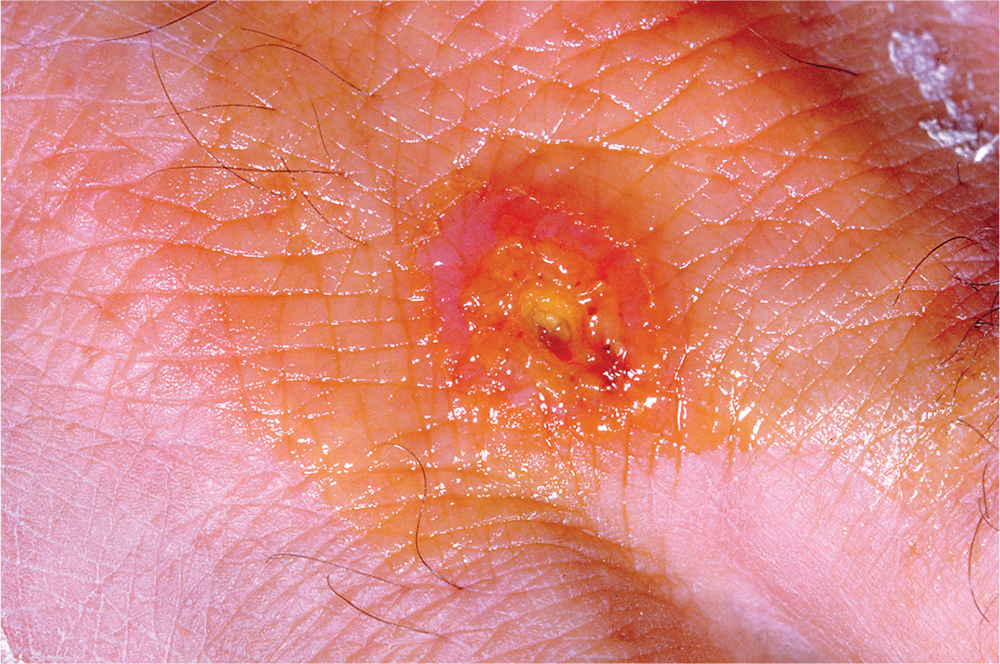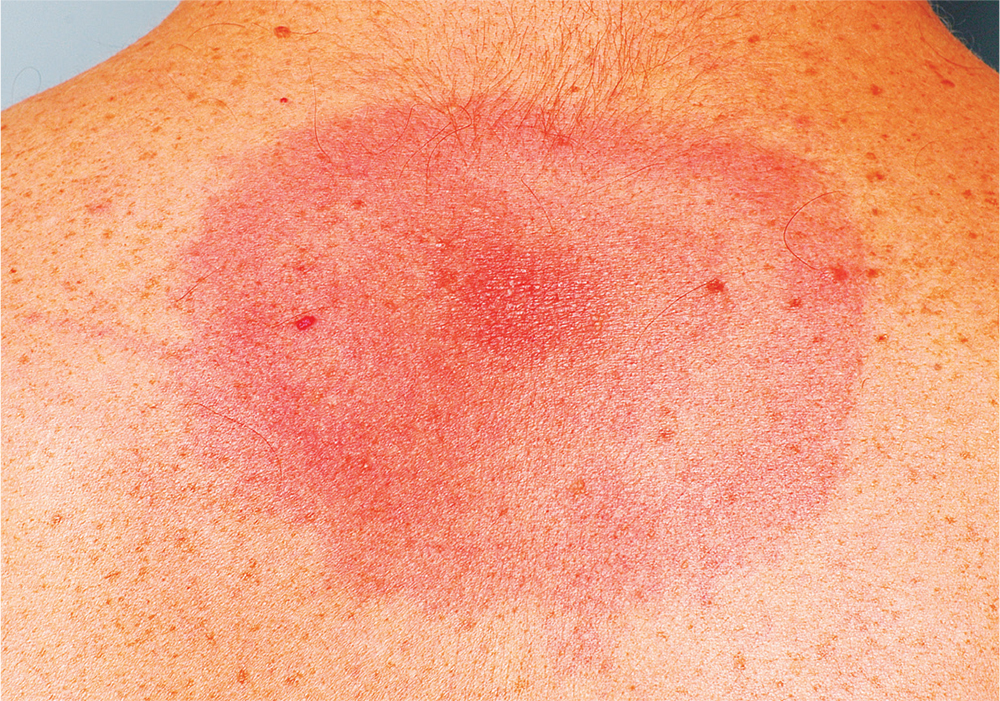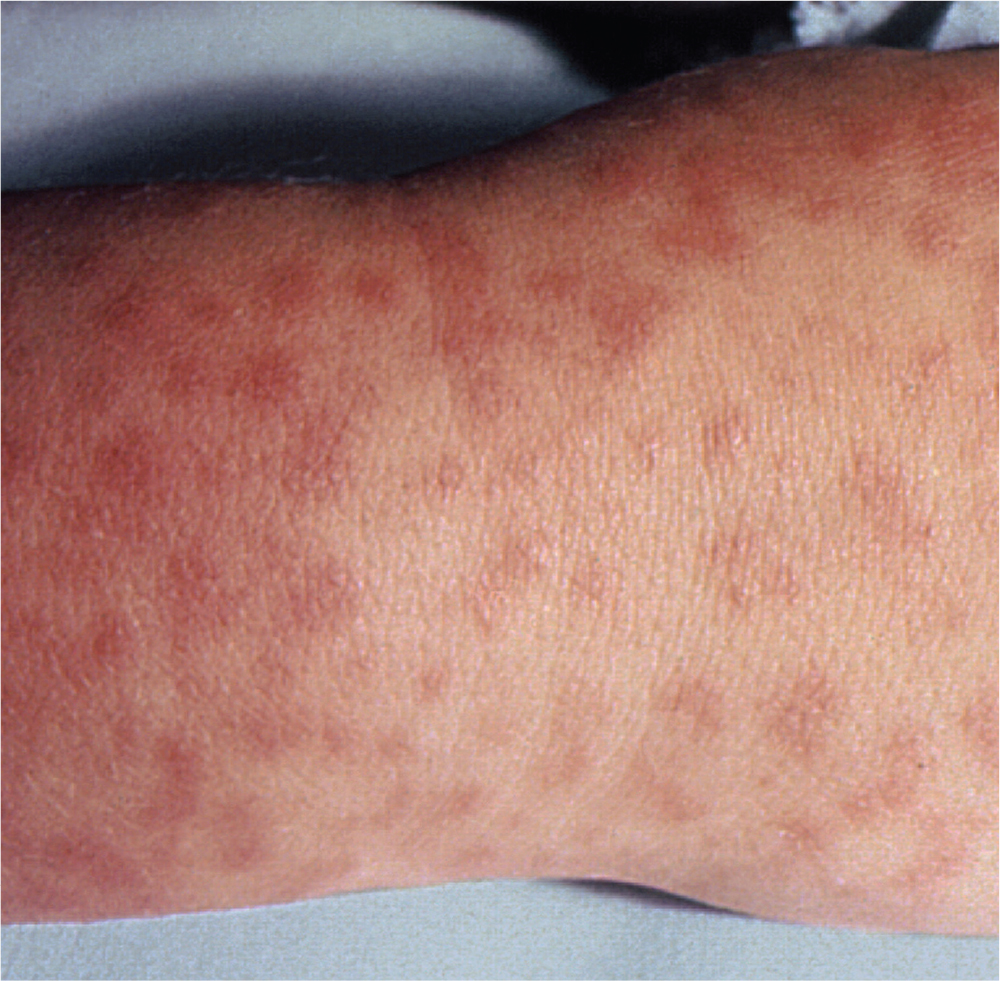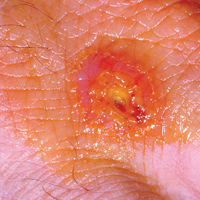User login
1. A 16-year-old boy presents with a skin ulcer on the dorsum of his hand and swollen glands in the proximal axilla. He works as a camp counselor in South Dakota, leading nature walks and teaching the children to care for animals, including the camp’s rabbits. Several weeks ago, he developed a fever of 103°F, fatigue, and body aches, followed by the appearance of the skin lesion.

Diagnosis: Tularemia—also called rabbit fever or deer fly fever—is caused by the bacterium Francisella tularensis. It is an insect-borne pathogen of rabbits, squirrels, and other rodents, most commonly found in the western United States and Russia. Symptoms vary by mechanism of exposure but include skin ulcers; irritation and inflammation of the eye; sore throat, mouth ulcers, and tonsillitis; lung involvement with cough, chest pain, and difficulty breathing; and swelling of regional lymph nodes. Tularemia can be successfully treated with antibiotics.
For more information, see “Pneumonic Tularemia Presenting With a Vesicular Eruption.” Cutis. 2015;95(4):E17-E18.
2. About 10-12 days after hiking in the Appalachian Mountains, this young woman presents with a 7-in circular rash on her upper back that is slightly warm to the touch. She denies fever, pruritus, and joint pain.

Diagnosis: Lyme disease is the most common tick-borne illness in the United States, with more than 25,000 confirmed cases in 2014. It is concentrated mostly in the northeast and upper Midwest, although in 2014, only five states (Colorado, Hawaii, Louisiana, New Mexico, and Oklahoma) reported no incidence. Lyme disease is caused by Borrelia burgdorferi, which is transmitted to humans by the Ixodes tick.
For more information, see “Beyond the bull's eye: Recognizing Lyme disease.” J Fam Pract. 2016;65(6):373-379.
3. A 42-year-old Native American farmer in Arizona has a reddish purple petechial rash on his ankles and feet. Upon questioning, he reports that about three weeks ago he had a slight fever with headache and malaise. Then, last week, he noticed small, flat, pink, nonitchy macules on his wrists, forearms, and ankles; they are now spreading to the trunk.

Source: CDC
[https://www.cdc.gov/rmsf/symptoms/index.html]
Diagnosis: Rocky Mountain spotted fever, now reported to the CDC as spotted fever rickettsiosis, is a tick-borne illness caused by the gram-negative intracellular bacterium Rickettsia rickettsia. It is endemic in the Southeastern and South Central United States. Most cases occur between April and September, coinciding with the active season of the vector tick species. Early diagnosis is critical because untreated RMSF may progress to fulminant systemic illness.
For more information, see “Fever and Rash in a 3-Year-Old Girl: Rocky Mountain Spotted Fever.” Cutis. 2002;70(3):165-168.
1. A 16-year-old boy presents with a skin ulcer on the dorsum of his hand and swollen glands in the proximal axilla. He works as a camp counselor in South Dakota, leading nature walks and teaching the children to care for animals, including the camp’s rabbits. Several weeks ago, he developed a fever of 103°F, fatigue, and body aches, followed by the appearance of the skin lesion.

Diagnosis: Tularemia—also called rabbit fever or deer fly fever—is caused by the bacterium Francisella tularensis. It is an insect-borne pathogen of rabbits, squirrels, and other rodents, most commonly found in the western United States and Russia. Symptoms vary by mechanism of exposure but include skin ulcers; irritation and inflammation of the eye; sore throat, mouth ulcers, and tonsillitis; lung involvement with cough, chest pain, and difficulty breathing; and swelling of regional lymph nodes. Tularemia can be successfully treated with antibiotics.
For more information, see “Pneumonic Tularemia Presenting With a Vesicular Eruption.” Cutis. 2015;95(4):E17-E18.
2. About 10-12 days after hiking in the Appalachian Mountains, this young woman presents with a 7-in circular rash on her upper back that is slightly warm to the touch. She denies fever, pruritus, and joint pain.

Diagnosis: Lyme disease is the most common tick-borne illness in the United States, with more than 25,000 confirmed cases in 2014. It is concentrated mostly in the northeast and upper Midwest, although in 2014, only five states (Colorado, Hawaii, Louisiana, New Mexico, and Oklahoma) reported no incidence. Lyme disease is caused by Borrelia burgdorferi, which is transmitted to humans by the Ixodes tick.
For more information, see “Beyond the bull's eye: Recognizing Lyme disease.” J Fam Pract. 2016;65(6):373-379.
3. A 42-year-old Native American farmer in Arizona has a reddish purple petechial rash on his ankles and feet. Upon questioning, he reports that about three weeks ago he had a slight fever with headache and malaise. Then, last week, he noticed small, flat, pink, nonitchy macules on his wrists, forearms, and ankles; they are now spreading to the trunk.

Source: CDC
[https://www.cdc.gov/rmsf/symptoms/index.html]
Diagnosis: Rocky Mountain spotted fever, now reported to the CDC as spotted fever rickettsiosis, is a tick-borne illness caused by the gram-negative intracellular bacterium Rickettsia rickettsia. It is endemic in the Southeastern and South Central United States. Most cases occur between April and September, coinciding with the active season of the vector tick species. Early diagnosis is critical because untreated RMSF may progress to fulminant systemic illness.
For more information, see “Fever and Rash in a 3-Year-Old Girl: Rocky Mountain Spotted Fever.” Cutis. 2002;70(3):165-168.
1. A 16-year-old boy presents with a skin ulcer on the dorsum of his hand and swollen glands in the proximal axilla. He works as a camp counselor in South Dakota, leading nature walks and teaching the children to care for animals, including the camp’s rabbits. Several weeks ago, he developed a fever of 103°F, fatigue, and body aches, followed by the appearance of the skin lesion.

Diagnosis: Tularemia—also called rabbit fever or deer fly fever—is caused by the bacterium Francisella tularensis. It is an insect-borne pathogen of rabbits, squirrels, and other rodents, most commonly found in the western United States and Russia. Symptoms vary by mechanism of exposure but include skin ulcers; irritation and inflammation of the eye; sore throat, mouth ulcers, and tonsillitis; lung involvement with cough, chest pain, and difficulty breathing; and swelling of regional lymph nodes. Tularemia can be successfully treated with antibiotics.
For more information, see “Pneumonic Tularemia Presenting With a Vesicular Eruption.” Cutis. 2015;95(4):E17-E18.
2. About 10-12 days after hiking in the Appalachian Mountains, this young woman presents with a 7-in circular rash on her upper back that is slightly warm to the touch. She denies fever, pruritus, and joint pain.

Diagnosis: Lyme disease is the most common tick-borne illness in the United States, with more than 25,000 confirmed cases in 2014. It is concentrated mostly in the northeast and upper Midwest, although in 2014, only five states (Colorado, Hawaii, Louisiana, New Mexico, and Oklahoma) reported no incidence. Lyme disease is caused by Borrelia burgdorferi, which is transmitted to humans by the Ixodes tick.
For more information, see “Beyond the bull's eye: Recognizing Lyme disease.” J Fam Pract. 2016;65(6):373-379.
3. A 42-year-old Native American farmer in Arizona has a reddish purple petechial rash on his ankles and feet. Upon questioning, he reports that about three weeks ago he had a slight fever with headache and malaise. Then, last week, he noticed small, flat, pink, nonitchy macules on his wrists, forearms, and ankles; they are now spreading to the trunk.

Source: CDC
[https://www.cdc.gov/rmsf/symptoms/index.html]
Diagnosis: Rocky Mountain spotted fever, now reported to the CDC as spotted fever rickettsiosis, is a tick-borne illness caused by the gram-negative intracellular bacterium Rickettsia rickettsia. It is endemic in the Southeastern and South Central United States. Most cases occur between April and September, coinciding with the active season of the vector tick species. Early diagnosis is critical because untreated RMSF may progress to fulminant systemic illness.
For more information, see “Fever and Rash in a 3-Year-Old Girl: Rocky Mountain Spotted Fever.” Cutis. 2002;70(3):165-168.
